A hydrogen like atom (atomic number Z) is in a higher excited sate of quantum number n .This excited atom can make a transition to the first excited state by successively emitting two photon of energies and .Alternatively, the atom from the same excited state can make a transition to the second excited state by successively emitting two photon of energy and Determine the followings:
The value of atomic number (Z) is
According to the question,

We, know energy of electron in nth is given by
Case I
Energy emitted by photon,
=27.2 eV
So,
Case II
Energy emitted by photons,
On divinding Eq. (i) by Eq. (ii) we get
Substituding the value of n in Eq. (i) , we get
Topper's Solved these Questions
- ATOMSBook:DC PANDEYChapter:ATOMSExercise:Check point 12.1
Explore 14 Videos
- ATOMSBook:DC PANDEYChapter:ATOMSExercise:Check point 12.2
Explore 16 Videos
- ALTERNATING CURRENTBook:DC PANDEYChapter:ALTERNATING CURRENTExercise:JEE MAIN
Explore 63 Videos
- CAPACITORSBook:DC PANDEYChapter:CAPACITORSExercise:OBJECTIVE_TYPE
Explore 1 Video
Similar Questions
A hydrogen like atom (atomic number z) is in a higher excited state of quantum number n. This excited atom can make a transition to the first excited state by successively emitting two photons of energies 10.2eV and 17.0eV respectively. Alternatively the atom from the same excited state can make a transition to the second excited state by successively emitting 2 photons of energy 4.25eV and5.95eV respectively. Determine the value of (n+z)
View SolutionA hydrogen like, atom ( atomic number =Z) is in a higher excited state of quantum number n. This excited atom can make a transition to first excited state by successively emitting two photons of energies 10.20eV and 17.0 eV respectively. Alternatively, the atom from the same excited state can make a transition to second excited state by successively emitting two phons of energy 4.25 eV and 5.95eV respectively. Determine the values of n and Z.
View Solution
Knowledge Check
A hydrogen like atom (atomic number Z) is in a higher excited satte of quantum number n .This excited atom can make a transition to the first excited state by succesively emitting two photon of energies 10.20eV and 17.00eV .Alternatively, the atom from the same excited state can make a transition to the second excited state by successively emitting twio photon of energy 4.25ev and 5.95eV Determine the followings:
The excited sate (n) of the atom isA4B6C8D3A hydrogen like atom (atomic number Z) is in a higher excited satte of quantum number n .This excited atom can make a transition to the first excited state by succesively emitting two photon of energies 10.20eV and 17.00eV .Alternatively, the atom from the same excited state can make a transition to the second excited state by successively emitting twio photon of energy 4.25ev and 5.95eV Determine the followings:
The hydrogen -like atom in the question isALi2+BHeΘCHDNoneA hydrogen like atom (atomic number Z) is in a higher excited satte of quantum number n .This excited atom can make a transition to the first excited state by succesively emitting two photon of energies 10.20eV and 17.00eV .Alternatively, the atom from the same excited state can make a transition to the second excited state by successively emitting twio photon of energy 4.25ev and 5.95eV Determine the followings:
The atom during transition from n=1 to n=2 emit radiation in the region ofAVisibleBInfira-redCUVDNone
A hydrogen like species (atomic number Z) is present in a higher excited state of quantum number n. This excited atom can make a transitionn to the first excited state by successive emission of two photons of energies 10.20 eV and 17.0 eV respectively. Altetnatively, the atom from the same excited state can make a transition to the second excited state by successive of two photons of energy 4.25 eV and 5.95 eVv respectively. Determine the value of Z.
View SolutionA hydrogen like atom (atomic number Z) is in a higher excited state of quantum number n. The excited atom can make a transition ot the first excited state by successively emitting two photons of energy 10.2 eV and 17.0 eV, respectively. Alternatively, the atom from the same excited state can make a transition to the second excited state by successively emitting two photons of energies 4.25 eV and 5.95 eV, respectivley Determine the values of n and Z. (lonization energy of H-atom = 13.6 eV)
View SolutionA hydrogen-like atom (aatomic number Z) is in a hight excited state of quantum number n . This excited atom can make a transition to the first excited state by successively emitting two proton of energy 10.20eVand17.00eV, respectively.
Alternatively , the atom from the same excited state can make a transition to the second excited state by successively emitting two proton of energy 4.25eVand5.954eV, respectively. Determine the value of nandZ (ionization energy of hydrogen atom =13.6eV)
View SolutionA hydrogen like atom (atomic number z) is in a higher excited state of quantum number n. This excited atom can make a transition to the first excited state by successively emitting two photons of energies 10.2eV and 17.0eV respectively. Alternatively the atom from the same excited state can make a transition to the second excited state by successively emitting 2 photons of energy 4.25eV and5.95eV respectively. Determine the value of (n+z)
View SolutionA hydrogen like atom (atomic number = Z) is in higher excited state of quantum number n. This excited atom can make a transition to first excited state by successively emitting two photons of energy 22.94eV and 5.15eV. The atom from the same state n can make transition to second excited state by successively emitting two photons of energies 2.4eV and 8.7eV. Find values of n and Z.
View Solution
